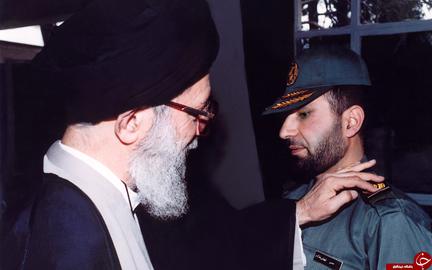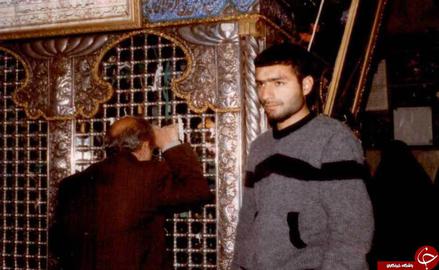The principal stage managers of the sprawling Revolutionary Guards organization are its generals and commanders. Each plays a leading role in one of the affiliate entities in this endless labyrinth. What do we know about them? Where do they come from? What is their record? Where do they stand? What are their positions? What do we know about their personal lives?
In this series, we have tried to look into the lives of the most important Revolutionary Guards’ commanders — before they joined the Guards, when they did and where they stand now.
Officials in the Islamic Republic recognize Hassan Tehrani Moghaddam as the father of Iran’s missile program, but Hassan Tehrani-Moghaddam believed the title more fitting for Mohsen Rafighdoost. And before him, the CEO of Iran Khodro Co. was recognized as the key figure in the program.
As is commonplace in Iran, Tehrani Moghaddam has been granted excessive praised within the regime’s official narrative, especially after his death. The praise is often exaggerated, and in some cases unverifiable — because the details of his career and the activities he was involved with remain classified to this day.
Hassan Tehrani Moghaddam was born on October 29, 1959 in the Sarcheshmeh neighborhood of Tehran, the fourth child born to the family. After receiving an associate’s degree in industry, his uncle tried to persuade him to continue his education in Canada along with his cousins, but the young Hassan declined, preferring to stay in his homeland of Iran.
According to his friends, prior to the revolution, Hassan Tehrani Moghaddam demonstrated skills in constructing homemade bombs. Later, as public protests intensified against the Shah’s regime, he joined a militia group in Gilan that was engaged in armed struggle against the government.
After the revolution and the establishment of the Islamic Revolutionary Guards Corps (IRGC), he was appointed as the head of IRGC Intelligence in the 3rd Region of the North. He married when he was 21 at the behest of Ayatollah Khomeini. Unlike other IRGC commanders, who often insisted on living an ascetic life, he much preferred the life of luxury. His son would later say that his father believed in living life to the fullest and consuming the best food and buying the finest clothing and cars. One of his colleagues also quoted the advice the IRGC officer gave him: “Buy good expensive cars and enjoy them. Don’t buy cheap cars. You deserve to live a happy and proper life.”
Since his first days in the IRGC, Tehrani Moghaddam took a special interest in the design and tactical employment of artillery on the battlefield. His focus did not go unnoticed. Hassan Bagheri, an IRGC commander known as one of the key strategists in the early days of the war against Iraq, would later commend his efforts in the Tariq-al-Quds Operation. The mortar barrage, a significant point in the battle, owed much to Tehrani Moghaddam’s planning and saw the Iranians retake the city of Bostan from Iraqi forces.
Tehrani Moghaddam went on to establish the IRGC’s artillery unit in 1981, choosing a Koranic verse as his command’s motto: “It wasn’t you who threw stones and rocks at them, it was God!” The same verse would later be emblazoned on missiles under his future command. One of his friends, Yaqub Zahedi, shared an anecdote about just how seriously he took the verse: “Sometimes, when he ordered a missile strike, the operating officer would warn him that the target was next to a school, but he would insist on the order and remind the officer of the verse and that God would guide the bomb to its intended destination.”
There are numerous stories about how Iran was able to build its first-ever missiles, many of which were copied from Libyan models. Some suggest that when Libyan experts traveled to Iran to consult the Islamic Republic on developing a missile system, IRGC officers stole their blueprints and copied them. Others believe that following Mohsen Rafighdoost’s negotiations with Libyan officials, Rafighdoost managed to purchase some of the missiles from Libya and Tehrani Moghaddam was able to reverse-engineer their design.
According to Mohsen Rezaei’s account, “When the war began, Saddam initiated a heavy bombardment of our cities. We were under huge pressure. So I called brother Rafighdoost, who was the head of IRGC Logistics, and told him that we had no other way but to retaliate with missile attacks as well. I sent him to Syria and Libya and even to North Korea to acquire missiles for us. But even after receiving them, we knew that we needed to build missile systems ourselves. I consulted with some of my brothers in the IRGC including Rashid, Safavi and Shamkhani, and we decided the best man for the job was Hassan Tehrani Moghaddam. So I asked him to leave the artillery and build a team to start our own missile unit. He stared at me for a second, but did not say a word. Later, another IRGC commander, brother Jafari, told me that when they were in Syria, Hassan told him about my order and said, ‘Artillery is easy, but missiles are complicated. I hope God helps me in doing this!’”
Tehrani Moghaddam, along with more than a dozen IRGC officers, was sent to Syria in 1984 to train on the use of “Scud-B” missiles. According to the book Yadegaran in the Ravayat-e Fath series, Tehrani Moghaddam made sure to counsel his fellow officers. “When the young IRGC officers got to their hotel in Syria, they were confronted with beautiful Syrian ladies all over the place. Hassan gathered his team in his room and told them: The war has just entered a new phase. We can’t be distracted with the warm welcome and kindness of Syrians. We need to take our mission seriously and make our best use of this training. No one should get lost in side-events and dramas.”
In October 2005, Hassan Tehrani Moghaddam was appointed as Deputy Commander of IRGC Aerospace. According to Amir Ali Hajizadeh, Chief Commander Jafari wanted to appoint him as the Commander of the Aerospace Force but Tehrani Moghaddam declined, preferring the junior post instead.
Tehrani Moghaddam was killed along with a number of other IRGC officers in 2011, when an explosion rocked the IRGC base in Malard near Tehran. Coincidentally, this was the same location that the IRGC had been carrying out final testing on its trans-continental ballistic missile. In the following days, Time Magazine would speculate that Mossad, the Israeli intelligence agency, was behind the blast.
In 2016, Tehrani Moghaddam's brother Mohammad Tehrani Moghaddam claimed: “This was not just a simple accident, but a carefully-planned operation. Mossad was trying to assassinate my brother for many years before that.” He later retracted these statements and the IRGC Aerospace Commander, AmirAli Hajizadeh, denied any Israeli involvement in the incident.
After Tehrani Moghaddam’s death, the Islamic Republic launched a huge propaganda campaign to praise its lost commander. But the regime’s lionization of its fallen commander ran into a troubling and embarrassing discovery nearly seven years after his death. On May 23, 2018, the New York Times published an article about Iran’s missile program. A team of California-based researchers reviewed Iranian state TV programming and had made a startling realization: the hagiographic videos and photos inadvertently revealed Tehrani Moghaddam’s involvement in a previously-unknown program to develop a secret secondary missile facility in the remote Iranian desert. In one photo, the late general can be seen in a photo with a box marked “Sharhood” behind him, the town believed to be the site of the secret facility.
It is ironic that in celebrating the work of one of its pioneering IRGC officers killed under suspicious circumstances, the Iranian regime might well have accidentally given away vital secrets about its clandestine missile program.
Also in the series:
Ghasem Soleimani: The Mythical Commander
Mohammad Ali Jafari: From Architect to Chief Commander
Mohsen Rezaei: Loser of War, Economics, and Politics
Yahya Rahim Safavi: Khamenei's First Appointment


























comments